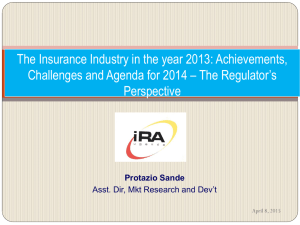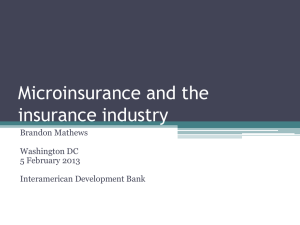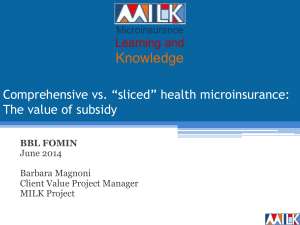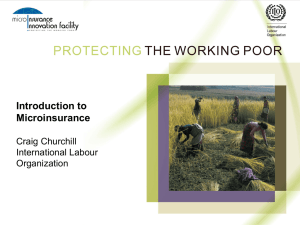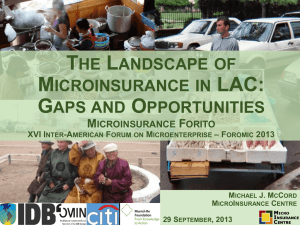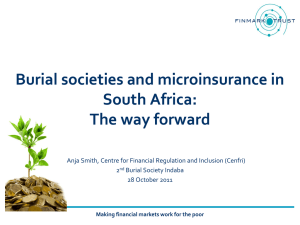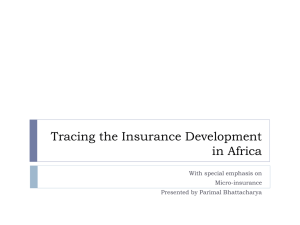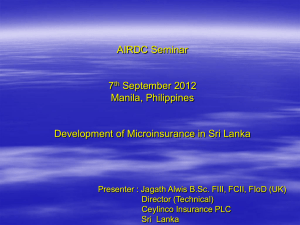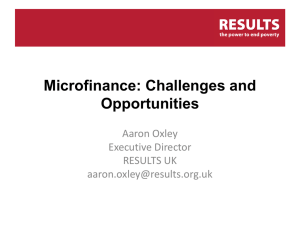pakistan microinsurance regulatory framework
advertisement
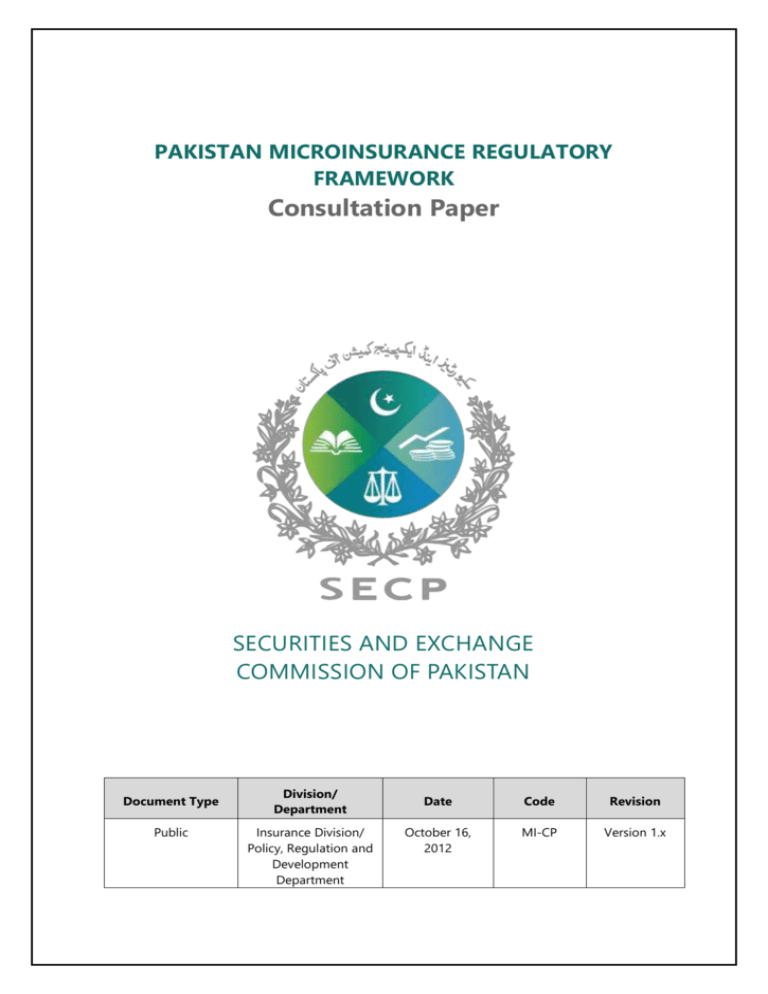
PAKISTAN MICROINSURANCE REGULATORY FRAMEWORK Consultation Paper SECURITIES AND EXCHANGE COMMISSION OF PAKISTAN Document Type Public Division/ Department Insurance Division/ Policy, Regulation and Development Department Date Code Revision October 16, 2012 MI-CP Version 1.x This Consultation Paper is part of the series of activities undertaken by Securities and Exchange Commission of Pakistan (SECP) for the development of the regulatory framework of Microinsurance in Pakistan. It is, in no way, meant to substitute the process of public consultation and undermine the importance of eliciting public opinion mandated under Section 40(2) of the Securities and Exchange Commission of Pakistan Act, 1997 (Act No. XLII of 1997), which shall be assumed once the tangible regulations are drafted, on the basis of stakeholders input. The Securities and Exchange Commission of Pakistan thankfully acknowledges the support provided by the FIRST Initiative/ World Bank for developing microinsurance in Pakistan; however, this document does not necessarily depicts the point of view or recommendations by FIRST Initiative/ World Bank or its Consultants. Also, this document has not been authorized or approved by the FIRST Initiative/ World Bank in any way, expressed or implied. This document is mainly an improvised product from the staff of the Securities and Exchange Commission of Pakistan and the independent Consultants. Comments and feedback on this Consultation Paper shall be sent latest by November 15, 2012 to faraz.amjad@secp.gov.pk . A soft copy of this paper can also be requested by sending an email to above mentioned address. Prelude The Securities and Exchange Commission of Pakistan (SECP), as always, intends to work closely with the industry on the development of microinsurance and its regulatory framework, and will ensure the participation of the industry through working groups, quantitative impact studies and consultation feedback. A diagnostic study has been recently completed with the assistance from FIRST Initiative/ World Bank, covering the demand and supply-side analysis of microinsurance in Pakistan. The study forms the basis of stocktaking where the subject stands today and where it needs to be taken. This consultation paper is also part of such chain and is being circulated for the comments of stakeholders. The paper has been structured according to the following outline: A Introduction B Microinsurance policy, regulation and supervision – Principles C Scope and Objective of the Regulatory Framework D Defining Microinsurance Products D1 Microinsurance Definition D2 Contract & Disclosure D2A Waiting Period D2B Grace Period D2C Exclusions PAKISTAN MICROINSURANCE REGULATORY FRAMEWORK Consultation Paper 2 D2D Claims procedures D3 Product guidelines D4 Client Research D5 Product Submission E Intermediation E1 Microinsurance Agent E2 Appointment of Microinsurance Agent E3 Training & Functions of Microinsurance Agent E4 Reporting of Microinsurance Agent E5 Code of Conduct E6 Remuneration & Commission F Client Protection/Communication F1 Disclosure requirements F2 Complaints Handling F3 Codes of Conduct and Consumer Protection F4 Claims handling F5 Client Communication G Prudential regulation G1 Compliance requirements G2 Specialised Microinsurers H Institutional Regulation H1 Authorised Risk takers H2 Informal Risk takers H3 Information sharing H4 Claims Process I Regulatory Reporting I1 Data Collection PAKISTAN MICROINSURANCE REGULATORY FRAMEWORK Consultation Paper 3 I2 Reporting requirements The following sections would now depict the above outline in detail, encapsulating the crux of diagnostic study and recommendations forming the basis of the proposed regulatory framework. PAKISTAN MICROINSURANCE REGULATORY FRAMEWORK Consultation Paper 4 A Introduction International experience has shown that insurance can play an important role in helping the poor manage their risks by protecting the assets and incomes of low-income households when financial losses occur. This can help prevent them from falling further into poverty in the first place, or falling deeper into poverty, as a result of having to take children out of school to work, utilise savings, sell hard-earned assets, or obtain credit or other expensive means of post-event risk management methods available to them. This does not, however, imply that microinsurance, and particularly formal microinsurance, is the appropriate risk-management tool for all low-income individuals. Some may never be able to afford microinsurance, while others may opt for other risk management mechanisms at their disposal. Although, for those at very low levels of income, microinsurance may not be able to fully replace the need for government-funded social protection. It has been observed that the market for microinsurance in Pakistan remains severely underdeveloped due to the lack of awareness about the potential benefits of microinsurance among microentrepreneurs, small and landless farmers, women, and low-income households, and also due to the lack of effective mechanisms and targeted products to provide microinsurance services and address the existing or potential demand. Moreover, most of the activities in this sector remain broadly unsupervised due to the inexistence of a specific regulatory framework. This document outlines policy thrusts and direction for the establishment of a policy and regulatory environment that will encourage, enhance and facilitate the safe and sound provision of microinsurance products by the formal insurance sector. It also identifies and promotes a system that will protect the rights and privileges of those who are insured. The following recommendations set out the basis for regulations for Microinsurance; Draft regulatory framework for both existing and new microinsurance providers; Draft framework for microinsurance accounting & regulatory reporting; Draft framework for code of conduct for microinsurance agents and code of consumer protection. Section B sets out some guiding principles and objectives when setting microinsurance policy, regulations & supervision. Section C sets out the scope and objective of the regulatory framework. Product regulation, Sections D and onwards set out regulatory recommendations for Microinsurance Intermediaries, Client protection, Prudential regulation, Institutional regulation and Regulatory reporting. This document is meant to be a companion and consultation document to the formal microinsurance regulations and guidance. The Appendices set out fuller details as appropriate. B Microinsurance policy, regulation and supervision – Principles PAKISTAN MICROINSURANCE REGULATORY FRAMEWORK Consultation Paper 5 The purpose of growing microinsurance provision is to extend financial inclusion in the insurance domain. The objective with financial inclusion is that individual consumers, particularly low-income consumers currently excluded from using formal financial sector services, must be able to access and on a sustainable basis use financial services that are appropriate to their needs and provided by registered financial service providers. Detailed below are international guidelines1 to grow the formal microinsurance market. Such principles suggest that this can be done by (i) formalising existing informal providers of insurance; (ii) encouraging existing commercial insurers to reach out to lower market segments (referred to in these guidelines as outreach); and (iii) encouraging new entrants, both domestic and foreign, that are particularly focused on the low-income market. To develop microinsurance markets, it is suggested that the following general objectives be pursued: i. ii. iii. iv. Facilitate both outreach and formalisation, ensuring a level playing field for big and small players where they seek to serve the same market; Promote products, providers and distribution channels that will trigger the favourable introduction of low-income clients to insurance and its benefits; Adopt risk-based regulation, tailoring regulation to the distinctive risks posed by microinsurance products and intermediation; Minimise the regulatory burden on underwriting and intermediation; To develop microinsurance markets, it is suggested that the following guiding principles be observed: i. ii. iii. iv. v. vi. vii. viii. ix. x. C Target market: Identify, define and understand the target market; Broader policy: Develop microinsurance policy as part of broader goal of financial inclusion; Definitions: Define allowable microinsurance product categories; Risk nature: Tailor regulation to the risk character of microinsurance thus entities writing the same kind of risk face a similar regulatory burden; Multiple players: Allow multiple players with flexible approaches including multiple legal forms to underwrite microinsurance, if appropriate; Informal: Provide a path for formalisation of informal approaches; Distribution: Allow flexibility in distribution approaches; Enrolment: Build on a mandatory market and also foster a voluntary market; M&E: Monitor and evaluate market developments to respond. Facilitate information sharing; and Enhanced supervision: Use market capacity to support supervision in low-risk areas. Scope and Objective of the Regulatory Framework This paper is expected to cover the provision of microinsurance, by the formal insurance sector, that cover the risk protection needs of low income households. It is not intended to cover social schemes 1 Emerging Guidelines for microinsurance policy, regulation and supervision (A2ii, 2009) PAKISTAN MICROINSURANCE REGULATORY FRAMEWORK Consultation Paper 6 and risk protection programs administered and implemented directly by government. However if such a social insurance scheme or risk protection program involves an insurer then such schemes or programs will be covered by this framework. The paper also provides a policy and regulatory environment direction that will facilitate the participation of the insurance sector in providing risk protection for low-income households and ensure that the rights and privileges of the insured poor will be protected and promptly acted upon. The paper builds on the work recently completed and documented in the Diagnostic study of Microinsurance in Pakistan2. This study assessed the demand and supply of microinsurance, the regulatory environment and produced a number of policy recommendations for SECP and other parties, to consider. The key recommendations from this diagnostic form the basis of the policy thrust of this paper, which is intended to explain the proposed Microinsurance regulatory framework and the rationale for the Microinsurance regulations and guidelines. The following sections set out the key policy recommendations and the related regulatory approach: - D Defining Microinsurance Products; Intermediation Regulation; Client Protection; Prudential Regulation; Institutional Regulation; and Regulatory Reporting. Defining Microinsurance Products These are the regulatory directions in order to effect and ensure that the relevant policy recommendations from the Diagnostic study are implemented, as they relate to: (i) Defining Microinsurance; (ii) Contract & Disclosure; (iii) Product Features; (iv) Underwriting Guidelines; (v) Client Research; and (vi) Product Submission Procedures. The key regulatory approaches to be used are identified, namely the use of Microinsurance regulations and guidelines. D1 Microinsurance Definition At a basic level, microinsurance refers to insurance that is accessible by low-income households. To turn this conceptual definition3 into a practical one, wide enough to facilitate the development of a dynamic microinsurance market, it is recommended that the definition should reflect the features of insurance required by low-income households and generate low prudential risk and be straightforward to distribute. As such it was considered important that a quantitative definition be adopted to ensure clarity and consistency in categorisation by varying insurers. 2 “Assessment of Demand and Supply of Microinsurance in Pakistan” conducted in May 2012 3 “The South African Microinsurance Regulatory Framework” (2011) PAKISTAN MICROINSURANCE REGULATORY FRAMEWORK Consultation Paper 7 However, it is also important that the definition is “quantitative-light” i.e. quantitative but also not too complicated to implement. To ensure consistency and appropriateness over time, this definition should be subject to regular review by SECP. A simple definition is being proposed on the basis of Sum Insured, rather than premium, which is considered more representative of the insurance needs of the low-income population. This is considered to be more likely linked to the financial loss the insured is facing and is seeking insurance for. As the definition includes the term “low-income person” it is important to also quantify what is considered to be a low-income person. This definition is linked to a standard measure of income produced by the Government of Pakistan, under the annual Economic Survey of Pakistan, subject to the regular review for adequacy by SECP. In the definition, it is important to be clear that microinsurance is insurance and more simply is a special category of insurance and not a new class of insurance. As such it is defined as either life microinsurance or non-life microinsurance. Though, there are a number of allowable classes of insurance, for life and non-life in the Insurance Ordinance, 2000 4, that are not considered relevant for Microinsurance. As such microinsurance is defined for the life classes and non-life classes considered to be where microinsurance needs are highest, namely; ordinary life, accident and health, fire & property damage and agriculture insurance. In line with current market practice, both a life insurer and non-life insurers will be able to provide health microinsurance (Class 4 under Life and Class 7 under Non-Life as defined in the Ordinance). It is not necessary to define insurance as this is clearly defined in the Ordinance. The above stated definition will form the part of proposed Microinsurance regulations. D2 Contract & Disclosure Given the low literacy level of the target market, it is important that key information necessary to make an informed decision be fully disclosed by the insurer and intermediary. All microinsurance policies should clearly state the benefits and terms of coverage. In this regard, all insurers providing microinsurance shall ensure that contract provisions can be easily understood by the insured and printed in local vernacular language, while the documentation requirements are kept simple. The contract & disclosure requirements will form part of the Microinsurance regulations. There are four typical risk management tools for the insurer to address the key insurance risks such as adverse selection, moral hazard and fraud. However these areas are also significantly different for microinsurance as compared to conventional insurance. For a successful microinsurance product, it is important to adopt a more practical and pragmatic approach to these four policy conditions. 4 Further, all references in this document referring to Insurance Ordinance 2000 shall be referred as Ordinance, which is the primary legislation of insurance in Pakistan. PAKISTAN MICROINSURANCE REGULATORY FRAMEWORK 8 Consultation Paper D2A Waiting Period Waiting periods are used to reduce the risk of adverse selection in situations where no individual underwriting occurs. Practical waiting periods can be adopted for microinsurance products. The following waiting periods are proposed to be allowable for microinsurance products: maximum of 6 months for death & disability due to natural causes for policyholders who are less than 65 years of age upon entry; no waiting period proposed to be allowed for accidental death & disability as accidental policies have limited adverse selection risk. The above stated waiting period requirement will form part of the Microinsurance regulations. The imposition of a waiting period could adversely affect policyholders if they move between insurers. The risk of adverse selection may already have been dealt with and the need for another waiting period with another insurer may not be necessary. Therefore, it is recommended that insurers develop an arrangement whereby they can share information and make specific allowance for an insured switching insurer and who has already served a waiting period. This above stated waiting period recommendation will form part of the Microinsurance guidelines. D2B Grace Period Many microinsurance policyholders, especially those in the informal sector and seasonal workers, are likely to have irregular income streams which may make it difficult for them to maintain regular premium payments. To ensure that such policyholders are not unduly disadvantaged by their irregular cash flows, microinsurance policies are recommended to allow a grace period if premium is not paid when due. The following is considered to be allowed: As a minimum, cover to continue for one month after the due date of the premium. The outstanding premium may be paid any time during that month without compromising the insurance coverage. If the premium is not paid by the end of the grace period, the cover will cease at that date i.e. end of grace period. Should a policyholder submit a claim during the grace period, the value of the claim may be reduced by the sum of the unpaid premium, including any mark-up. The above stated grace period requirement will form part of the Microinsurance regulations. D2C Exclusions To ensure consistency and fair treatment of clients across the market, it is recommended to insurers that for base product design, there is no exclusion for pre-existing conditions. However, if an insurer wishes to include exclusion for specified pre-existing conditions, they may provide clear rationale why they wish to do so. This will form part of the product filing requirements. To avoid adverse selection, standard exclusions, such as suicide, will be allowed. The above exclusion requirement will form part of the Microinsurance regulations. D2D Claims procedures The claims process is a very important aspect of Microinsurance and an area where insurers typically have to adopt a more flexible and pragmatic approach, in order to enable the insured to make a claim PAKISTAN MICROINSURANCE REGULATORY FRAMEWORK Consultation Paper 9 as easily as possible. It is also important for the insurer to have a cost effective process to limit their claims administration costs. The microinsurance policy document must clearly state the documents required for a claim, the claims process and timeframe for settlement. This claims procedure disclosure requirement will form part of the Microinsurance regulations; however, the guidance on effective claims procedure will form part of the Microinsurance guidelines. D3 Product guidelines In order to guide the microinsurance sector and bring in learning from microinsurance programs in Pakistan and in other jurisdictions, there will be a prescription of underwriting guidelines. These are particularly important for group microinsurance policies as this is the most common and often most effective way to underwrite microinsurance. Building scale and retaining clients in a cost-effective and simple manner is also important, which is why automatic renewals are suggested. The guidelines will be recommended for insurers to follow when developing and issuing microinsurance products. The stated product advice will form part of the Microinsurance guidelines. D4 Client Research When developing and launching a Microinsurance program it is critically important to build the product around the clients’ risk management needs. Often the key reason, why a microinsurance program fails, is due to poor client research and a poor product fit to clients needs. It is not in the insurer or clients’ interest to offer a poorly designed product. On the converse, the most successful microinsurance programs are usually where there has been client research and there is a reasonable level of client value in the product. One has to be practical and one would not expect all insurers to conduct detailed client research for every Microinsurance product. This is why it is suggested that there be ongoing industry studies to develop an ongoing knowledgebase on low-income clients. In order to guide the microinsurance sector, there will be client research guidelines plus a requirement for some basic client research when developing the product. Insurers will be required to report on the level of client research they conduct, on their Microinsurance client base, as part of the Microinsurance product filing. The client research guidelines will form part of the Microinsurance guidelines and the reporting requirements will form part of the Microinsurance regulations. D5 Product Submission It has been found that the literacy level and understanding of insurance for microinsurance target market is usually very low. As such, it is important that products are designed in an appropriately simplified way, to support understanding of insurance products by consumers in this market. Every insurer shall be subject to the “File and Use procedure”5 for microinsurance with respect to filing of microinsurance products with SECP. Insurers will be required to submit and file microinsurance products at least 30 days prior to the intended launch date of the product. The filing requirement will “File and use” means that unless SECP instructs the insurer to desist from launching the product, or to alter certain product features, the insurer can proceed to launch the product PAKISTAN MICROINSURANCE REGULATORY FRAMEWORK 10 Consultation Paper 5 include among other items, an example of the proposed policy document, summary of product features including risk events covered, benefit level, risk rate, expense rates and the pricing basis used by the insurer. Exact filing requirements will be specified in detail in the Microinsurance regulations. Currently, all life insurers are required to submit their products to SECP, but this is not required of non-life insurers. This file and use requirement will thus be an additional requirement for non-life insurers, but it is intended to be straightforward process with minimal regulatory burden. The key objective of the File and Use procedure is to ensure insurers follow a consistent approach to developing a Microinsurance product and that SECP can keep a record of this and review/comment as and when required. The filing requirements are intended to provide guidance to the industry on what is considered as an appropriate Microinsurance product and the best practice approaches to product development. Every microinsurance product which is cleared by SECP for the purpose of microinsurance shall prominently carry the caption “Microinsurance Product”. The above stated Product Submission requirements will form part of the Microinsurance regulations. E Intermediation Low-cost distribution is essential to successful microinsurance development, though cost is not the only criteria. Distribution channels should be able to actively sell policies to clients and deliver microinsurance policies as close as geographically possible to the normal locations of low-income clients. International experience also shows that microinsurance uptake increases with the level of trust that potential clients have in the distribution channel, be that a retailer with a trusted brand, a bank with which the person has an existing banking relationship, a public utility, or another institution such as a religious group or trade union of which the person is a member. Not all of these intermediaries fit comfortably into the traditional broker/agent regulatory definitions. Neither can the traditional regulatory requirements be applied to such insurance intermediaries, be transferred to these channels with the same ease and in a manner allowing for low-cost intermediation. Different approaches, thus, are required. International best practices suggest allowing multiple categories of intermediaries, while particularly encouraging models that are able to actively sell products or at least are able to verbally disclose critical product information to the client. SECP as the regulator wishes to avoid prescriptive regulation that restricts the design and nature of potential intermediaries, beyond what is required for risk management purposes. Business models and technologies are changing at an increasing pace and regulatory systems are thus to be designed to accommodate changing models. However, it is strongly felt that increasing monitoring and reporting requirements can be utilised by SECP where the impact of models are not clear. The insurer must have a formal contractual relationship with the intermediary that outlines the respective obligations of the parties. This bestows joint responsibility on the insurer to ensure that its microinsurance policies are sold without consumer abuse and there must be an ease of consumer recourse. The underwriter/ intermediary must provide an acceptable consumer recourse option. At the very least the customer must be able to lodge a complaint and/or channel enquiries through the point of sale. The Microinsurance guidelines will attempt to address these guiding notes as appropriate. E1 Microinsurance Agent PAKISTAN MICROINSURANCE REGULATORY FRAMEWORK Consultation Paper 11 In addition to an insurance agent or corporate agent or broker licensed under the Ordinance, microinsurance products may be distributed through a specialised Microinsurance agent. It is intended that there be enough flexibility to allow for non-traditional agents and multiple categories of Microinsurance agents. The Ordinance allows for any body corporate or natural person to be an agent. This provides enough flexibility and it will be up to the insurer to decide who to work with as a Microinsurance agent. However, there will be clear guidance on what functions these Microinsurance Agents are expected to perform. The definition of Microinsurance Agent will form part of the Microinsurance regulations. E2 Appointment of Microinsurance Agent In line with the current practice, a microinsurance agent shall be appointed by an insurer by entering into a deed agreement, which shall clearly specify the terms and conditions of such appointment, including the duties and responsibilities of both the microinsurance agent and the insurer. There should be a clear provision within the agreement allowing for its termination, as appropriate. The process for appointment of the Microinsurance Agent will form part of the Microinsurance regulations. E3 Training & Functions of Microinsurance Agent It is important that Microinsurance Agents have a minimum level of understanding of Microinsurance and are trained in how to handle the key functions of their role. It is proposed that Microinsurance Agents undergo an approved microinsurance training program conducted by the insurer or a centralized licensing body, with a minimum of 20 hours of training. The microinsurance agent shall be required to perform functions as specified in the agency agreement. The requirement for training and the required functions will form part of the Microinsurance regulations. E4 Reporting of Microinsurance Agent The insurer shall be required to report details of their microinsurance agents to SECP as part of their annual returns. This reporting shall include details of numbers, qualifications, training, remuneration, turnover, sales volumes and area of operation of their Microinsurance agents. The above stated reporting requirement will form part of the Microinsurance regulations. E5 Code of Conduct As consumer protection is a critical part of Microinsurance every microinsurance agent shall abide by the code of conduct and the code of consumer protection. It will be required that the insurer shall ensure compliance of the code of conduct by every microinsurance agent. Any violation by microinsurance agent of the code of conduct or advertisement or disclosure norms should lead to termination of the agent’s appointment. The above stated requirement will form part of the Microinsurance regulations. PAKISTAN MICROINSURANCE REGULATORY FRAMEWORK Consultation Paper 12 E6 Remuneration & Commission As Microinsurance is a high-volume-low-margins product, it is important to have efficient cost structures and to keep expenses to a minimum. In addition, most Microinsurance products are shortterm, typically of one year duration. It is an international best practice in microinsurance to have target total expense margin of 20 to 30 percent 6, thus it is recommended that the regulations will set caps for the costs of the intermediary. The above stated remuneration/ commission principles will form part of the Microinsurance guidelines. F Client Protection/ Communication To complement the consumer protection mechanisms built into the product definition, requirement for product submission, as well as institutional, prudential and market conduct requirements, it is proposed that provisions be made for adequate disclosure, consumer recourse, code of conduct and client communication. F1 Disclosure requirements The microinsurance policy document must set out the minimum disclosure requirements being the same as the key features of a microinsurance contract. This must be written in simple vernacular language and also communicated directly to the insured by the Microinsurance Agent. These minimum disclosure requirements will include: Coverage, Period of cover, Risk and contingent events covered, Terms and conditions, Effectivity, Claims procedures, Dispute resolution, Waiting period, Grace period, Exclusions, Renewals process and Contestability. This can be communicated, for example, in a 2-page document or a single brochure, provided all the key items are disclosed to the insured. A sample of marketing material and policy documents, along with any other material to be used to communicate to the client, will be required to be provided to SECP as part of the filing of the product, for information purposes only. The above stated disclosure requirements will form part of the Microinsurance regulations. F2 Complaints Handling It is important that any complaint related to microinsurance contracts be acted upon by the concerned parties and/or SECP. It is recommended that complaints should be handled firstly, if possible, at the Microinsurance agent level. If this is not sufficient, then it should be handled by the insurer’s branch or relevant office, as the case may be. If this is also not sufficient, then it should be handled by the insurer’s head office. If the complaint is still not possible to resolve at the insurer or agent level then it could proceed to an Alternative Dispute Resolution mechanism, which is proposed to be developed at industry level with regulatory representation. Such a mechanism is less costly then 6 Key Performance Indicators for Microinsurance (Microinsurance Network) 2010 PAKISTAN MICROINSURANCE REGULATORY FRAMEWORK Consultation Paper 13 legal recourse and could be more effective for handling low-cost complaints. option will continue to be to proceed to the Insurance Ombudsman. The final recourse The microinsurance policy document should clearly state, in a local vernacular language, who to contact and how to lodge a complaint. The above stated complaints handling process will form part of the Microinsurance guidelines. F3 Codes of Conduct and Consumer Protection It is recommended that insurers and agents implement and follow a Code of Consumer Protection, which must also be communicated to the client. It is also recommended that Microinsurance agents follow a Code of Conduct that is managed by the insurer for which SECP will have a right to review. This code of conduct shall be consistent and refer to the code of consumer protection. The guidance on the above stated codes of conduct and/or consumer protection will form part of Microinsurance guidelines. However, the requirement to comply with the Code of Conduct will be part of the Microinsurance regulations. It is recommended that insurers develop and implement an independent internal dispute resolution (IDR) mechanism for client’s complaints & grievances. The above recommendation for IDR will form part of the Microinsurance guidelines. F4 Claims handling The process for settling claims must be efficient and easy for beneficiaries to manage. Claims represent the point at which insurance becomes tangible to policyholders. It is critical that claims processes be as efficient as possible, while still maintaining appropriate controls. It is recommended that insurers and agents implement and follow specific guidance for simplified claims procedures and claims documentation requirements for microinsurance products. The claims procedures guidance will form part of the Microinsurance guidelines. F5 Client Communication It is recommended that insurers and agents develop and implement a strategy for consumer education and awareness. It is also recommended that insurers and/or industry bodies develop and implement insurance awareness campaigns for low-income households, especially in rural areas. The above recommendation for consumer education and awareness will form part of the Microinsurance guidelines. It is recommended that insurers and agents develop and implement an explicit communication strategy at the Microinsurance agent level to explain the Microinsurance product features, premium, benefits, inclusions, exclusions and claim processes to the client. Such a communication strategy should be monitored by the insurer. SECP will have the right to review such a strategy, both in terms of planning and implementation. Such a communication strategy could, for example, consist of certain amount of time allotted for client communication during the sales period. The above recommendation for an explicit communication strategy will form part of the Microinsurance guidelines. PAKISTAN MICROINSURANCE REGULATORY FRAMEWORK Consultation Paper 14 G Prudential regulation In line with international best practices7, the capital requirements for microinsurance should reflect the underlying risks involved with providing the product to its users. However, in practice it may be appropriate to recognise that much microinsurance may be presented and provide as part of a larger financially related package. G1 Compliance requirements All entities registered and licensed to provide microinsurance products shall comply with the prudential requirements of SECP. For life and non-life insurers, these will be the current minimum capital requirements and solvency requirements as laid out in the Ordinance, and the associated rules. For life insurers, it will be required that the annual Financial Condition Report specifically consider the implications of the microinsurance business on the financial soundness of the insurer. The above stated compliance requirements will form part of the Microinsurance regulations. G2 Specialised Microinsurers SECP may consider issuing specific prudential requirements for specialised microinsurers. These requirements will include, but not be restricted to, allowance for varied capital requirements, expanded admitted assets and limits on the type of products allowed by specialised microinsurers. The provision to issue specific prudential requirements will form part of Microinsurance regulations. These specific prudential requirements will be issued as a specific and separate directive on Microinsurance. H Institutional Regulation In developing licensing requirements for microinsurance providers, it is recommended that SECP will adopt a proportionate, flexible and pro-active approach. For example, consideration should be given to the capacity of both the microinsurance providers and the product distributors to protect the interests of those insured over all the links in the insurance value chain, the level of government interest and support for microinsurance, and the typically low level of insurance knowledge and awareness of many microinsurance recipients H1 Authorised Risk takers Provision of a microinsurance product shall only be undertaken by entities registered and licensed by SECP as an Insurer. These entities shall include, and are not limited to, the following: Life Insurers, Non-life Insurers, including public and private entities. The above stated requirements are part of 7 Emerging Guidelines for Microinsurance policy, regulation and supervision (A2ii 2009) PAKISTAN MICROINSURANCE REGULATORY FRAMEWORK Consultation Paper 15 current requirements within the Ordinance and will also form implicit part of the Microinsurance regulations. H2 Informal Risk takers As stated in the Ordinance, it is not legally possible to provide insurance without having an insurance license and thus to do so would be in breach of the Ordinance. However there may be cases of informal insurance occurring. All entities providing microinsurance that are not licensed as an Insurer, but that intend to continue provide microinsurance products, shall be required to formalize their operations, using the following options: Partner with licensed microinsurance providers; or Buy a microinsurance product through a licensed microinsurance agent or broker. The above stated requirements will form part of the Microinsurance regulations. H3 Information sharing SECP as the regulatory will collaborate and exchange information to ensure that informal insurance and insurance-like activities are under the coverage of the regulatory environment in order to minimize regulatory arbitrage among regulated entities. The above stated recommendations will form part of the Microinsurance regulations. H4 Claims Process Payment and Settlement of Claims: All entities providing microinsurance products should process and settle claims within 10 working days from receipt of complete required documents. The Ordinance does not allow for the mandating of hierarchy of claims approval times, therefore the stated recommendation for turnaround time will form part of the Microinsurance guidelines. Documentary Requirements: The microinsurance provider should accept substitute documents for settlement of claims. SECP will issue appropriate guidance providing for the minimum documentary requirements and recommended claims procedures. The above stated requirements will be within the Microinsurance regulations. I Regulatory Reporting I1 Data Collection Data collected with regard to microinsurance should be segregated from other data. Each insurer conducting microinsurance business will be required to report on its microinsurance business, PAKISTAN MICROINSURANCE REGULATORY FRAMEWORK Consultation Paper 16 separately. Each insurer will be required to find a means within its management information system to record and identify its microinsurance business distinctively. However, it is at the insurer’s discretion to decide the exact means to do so within its internal management information system. The above stated recommendations will form part of the Microinsurance guidelines. I2 Reporting requirements Each insurer will be required to provide product details and pricing prior to launch, on a “File and Use basis”. For each insurer conducting microinsurance business, it will be required to provide regulatory returns under current reporting requirements, as for conventional business, but with Microinsurance identified separately. Each insurer will also be required to provide annual reporting on claims statistics as per the format prescribed by SECP. This reporting will be at the same time as the usual regulatory reporting. The above stated reporting requirements are part of the Microinsurance regulations. PAKISTAN MICROINSURANCE REGULATORY FRAMEWORK Consultation Paper 17
